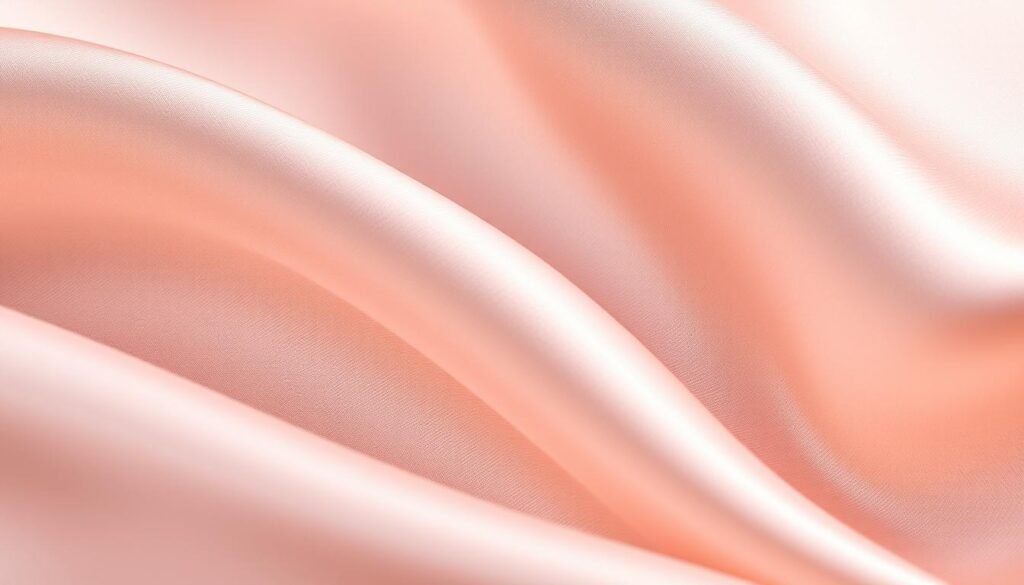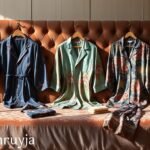Have you ever thought about the differences between satin and silk fabrics? These two fabrics seem similar but are actually quite different in many ways1. Satin is made using a special weaving method. It can be made from many fibers, like polyester, nylon, or rayon1. Silk, on the other hand, comes from the cocoons of silkworms. It’s known for being soft, breathable, and shiny.
Many people think “satin silk” means real silk, but it’s not always true1. This term often means a man-made material that looks like silk1. Satin silk may look shiny like silk, but it doesn’t have the same health benefits. Real silk is hypoallergenic, antibacterial, and keeps your body temperature just right1.
Key Takeaways
- Satin is a weaving technique, not a fabric type, and can be made from various synthetic fibers or silk.
- Genuine silk is a natural, breathable fiber with unique properties like hypoallergenic and temperature-regulating qualities.
- “Satin silk” is often a synthetic imitation that lacks the true benefits of authentic silk fabric.
- Understanding the differences between satin and silk can help you make informed choices for your clothing, bedding, or interior design needs.
- Silk may be more expensive initially, but it offers long-term benefits for health, sleep quality, and overall well-being.
Understanding Silk: A Luxurious Natural Fiber
Silk comes from the cocoons of silkworms, like the Bombyx mori2. It’s known for feeling luxurious, being strong, and letting air through. People love it for clothes, bedding, and decorating their homes2.
Silk Production: From Silkworm to Luxurious Fabric
Creating silk is quite interesting. Silkworms eat leaves for about 40 days, then make a pod to pupate2. Inside this pod is a special fluid that turns into silk threads2. One cocoon can give a lot of silk, showing how hard it is to make this fabric.
Properties and Benefits of Silk Fabric
Silk is famous for its amazing qualities2. It’s super smooth and shiny, strong, and stretchy2. It’s also seen as a green choice, even if it’s not always good for the animals2. Silk keeps you cool and lets air in, making it great for many uses2.
Silk is pricier but its special features and benefits make it popular in the textile world. Silk’s unique qualities and how it’s keep it in high demand.
“Silk is a natural fiber that is renowned for its luxurious feel, exceptional strength, and breathability, making it a popular choice for a wide range of applications.”
What Is Satin Silk Fabric? Differences & Uses
Satin is a special way to weave fabric that makes it smooth and shiny. It can be made from many materials, like silk, cotton, and polyester3. But satin is often linked with the luxury of silk because of its shiny look and feel. Yet, satin and silk are not the same, with different uses and qualities.
Silk comes from silkworms, especially the bombyx moi kind3. These worms eat leaves for 40 days, then spin a cocoon to change into moths3. One cocoon can give a lot of silk threads3. People have been making silk since 6000 BC3. Silk is very luxurious and expensive because of the high-quality fibers and hard work to make it3. Satin, on the other hand, can be made from many fibers, making it cheaper and easier to get.
Silk is loved for being soft, breathable, and warm3. Satin is known for its shiny look and is used in clothes, home decor, and costumes3. The thickness of satin depends on the fiber and how tightly the yarn is twisted3.
| Characteristic | Silk | Satin |
|---|---|---|
| Cost | More expensive4 | Less expensive4 |
| Sustainability | More sustainable4 | Less sustainable4 |
| Maintenance | Requires handwashing4 | Can be machine-washed4 |
| Breathability | More breathable4 | Less breathable4 |
| Durability | Stronger and more durable4 | Less durable and prone to snagging and piling4 |
In summary, satin and silk may look similar, but they are different in many ways. Satin is more affordable and versatile, while silk is valued for its luxury and natural fibers. The choice between satin and silk depends on what you need for your project.
Satin: A Weaving Technique, Not a Fabric
Satin is not a fabric type, but a weaving method. It has warp threads floating over many weft threads. This makes one side shiny and the other dull5. This special way of weaving makes satin look unique and wanted.
Fibers Used to Create Satin Fabric
Satin can be made from many fibers like silk, cotton, polyester, nylon, rayon, acetate, and viscose5. The fiber used changes the satin’s quality, durability, and price.
- Silk is a luxury fabric, breathable and shiny5.
- Polyester is strong and not expensive5.
- Rayon and viscose are man-made for satin fabrics.
Satin looks like silk but is a weaving method, not a fabric type6. Buyers should watch out for labels like “satin silk” or “silky satin”. These might mean synthetic fabrics, not real silk6.

“Satin can be made from any fiber, including polyester or rayon, to imitate the look of silk at a lower cost.”6
Knowing satin and silk apart is key when picking quality fabrics for projects7. Being smart in choosing helps you pick the best for your needs and likes.
Silk vs. Satin: Key Differences
Silk and satin look alike but are very different. Silk comes from silkworms and has a shiny, smooth feel. Satin is made from different fibers and has a shiny side and a dull side89.
Appearance and Texture Comparison
Satin feels silky but isn’t as soft as silk9. It’s made from synthetic fibers, not silk. Silk is soft, breathable, and keeps a good temperature9.
“Silk is the most renowned and highly regarded textile, offering unparalleled benefits in terms of comfort, durability, and sustainability. Satin, while visually striking, often lacks the inherent qualities of genuine silk.”
| Silk | Satin |
|---|---|
| Natural fiber derived from silkworms8 | Weaving technique applied to synthetic and natural fibers9 |
| Lustrous, smooth texture with sheen on both sides8 | Shiny, smooth surface on one side, dull matte on the other9 |
| Inherently soft, breathable, and temperature-regulating9 | Slippery or silky texture, but lacks the softness of silk9 |
Silk and satin may look alike but are really different. They have different textures and uses. Knowing these differences helps when choosing fabrics.
Pros and Cons of Silk Fabric
Silk is a luxury fabric with many benefits. It’s naturally breathable, making it great for clothes and bedding10. Silk also wicks away moisture, regulates temperature, and is hypoallergenic10. It’s strong and lasts a long time, making it versatile.
But, silk is very expensive11. Getting silk can be hard on animals, as silkworms die in the process10. Silk also needs special care, like handwashing, which can be a hassle.
| Silk Fabric Pros | Silk Fabric Cons |
|---|---|
|
|
Choosing silk fabric depends on your needs and what you value11. If you want luxury, breathability, and durability, silk might be perfect. It’s pricier and needs special care, though.
“Silk is a remarkable fabric that combines natural beauty, exceptional quality, and unparalleled comfort. While its cost may be a consideration, the benefits it offers make it a worthy investment for many.”
Choosing between silk and other fabrics like satin depends on what you like, your project needs, and your budget11. Knowing the good and bad about silk helps you make a smart choice.
Advantages and Disadvantages of Satin Fabric
Satin fabric is known for its shiny, luxurious look. It’s used in many things like clothes, home items, and costumes. It’s cheaper than silk12 and can be washed by machine12. But, satin isn’t as strong as silk12 and can get snagged or pilled12. It might not breathe well, depending on what it’s made of13.
Durability and Maintenance Considerations
Satin has been around for about 2,000 years, starting in China14. Its special weave makes it shiny and smooth14. Satin can be silk, nylon, rayon, or polyester14. Silk satin is stronger than other kinds12.
It’s important to take good care of satin. Don’t use high heat or harsh cleaners12.
| Satin Fabric Advantages | Satin Fabric Disadvantages |
|---|---|
| Relatively low cost compared to silk12 | Less durable than silk12 |
| Machine-washable12 | More prone to snagging and pilling12 |
| Shiny, smooth texture | Potentially less breathable13 |
| Versatile in various applications | Requires special care and maintenance |

Satin looks and feels luxurious and is very versatile14. But, it can be hard to work with because it’s slippery and snags easily14. You can wash satin at home if it’s synthetic or cotton, but silk satin needs dry cleaning14. When washing satin by hand, use a gentle cycle with cold water. Don’t squeeze it dry or use a dryer to keep it looking good14.
“Satin is known for its luxurious look and feel, versatility, durability, and wrinkle resistance, making it a popular choice for various applications.”
In conclusion, satin has many good points like being affordable, easy to wash, and smooth. But, it’s not as strong as silk and might not breathe well. Taking good care of satin is key to keeping it looking nice121413.
Choosing Between Silk and Satin for Your Project
When picking between silk and satin for a project, think about what each fabric offers. Silk is great for clothes, bedding, and decor that need to breathe and keep a steady temperature. It also feels luxurious and natural15. Silk comes from silkworms and is famous for being super soft and smooth15. It’s also breathable, which helps keep you cool or warm15.
Satin is a good choice if you want a shiny look without spending a lot, like in clothes, furniture, or costumes15. Satin looks fancy because it’s smooth and shiny. It can be made from silk, polyester, nylon, or rayon15. It’s great for evening wear, wedding dresses, accessories, and furniture because it drapes well and comes in many colors and finishes15.
Choosing between silk and satin depends on what you need for your project, your budget, and what you like16. Silk is pricier because it’s harvested in a special way1615. But, think about what you want your final product to look like, feel like, and do15.
| Comparison | Silk | Satin |
|---|---|---|
| Fiber | Natural protein-based fiber | Can be made from various materials (silk, polyester, nylon, rayon) |
| Appearance | Glossy on both sides | Glossy surface, dull back |
| Texture | Smooth and soft | Smooth and shiny |
| Breathability | Highly breathable | Less breathable, can be moisture-absorbent |
| Durability | Very strong and durable | Less durable, can snag and pill |
| Cost | More expensive | Less expensive |
| Care | Requires handwashing | Can be machine-washed |
When choosing silk or satin for your project, think about what you want your final product to be like. Silk vs satin depends on your budget, how you plan to use it, and what you prefer. Knowing what each fabric offers helps you pick the best one for your needs.
Identifying Genuine Silk vs. Misleading “Satin Silk” Labels
When you’re looking for silk, it’s key to know the real deal from fake “satin silk” or “silky satin.” These fake fabrics look and feel like silk but don’t have its natural qualities. They are often made from polyester, nylon, or rayon17.
Make sure you check the fabric’s details. Look for the momme weight to confirm it’s real silk18. Real silk should say “100% pure mulberry silk” to be sure18. It also should shine softly, unlike fake fabrics18.
- Polyester satin feels hard and plastic-like, unlike real silk’s softness18.
- Quality silk has details like silk grade and momme weight, showing it’s top-notch18.
- Companies like Mulberry Park Silks offer different silk qualities, like 19, 22, 30 momme, for better quality and lasting longer18.
- Look for OEKO-TEX certification for safe and pure silk, which means it’s good quality18.
- Don’t pay too little for silk, like under $20 for a pillowcase, as it might be fake18.
The silk burn test is a good way to tell real silk from fake. Real silk smells like burnt hair and leaves ashes. But don’t use the “silk ring test” for big items like sheets or pillowcases18.
Stay alert to spot the real silk from satin silk labels. This way, you’ll get the luxury and quality silk is famous for, not fake stuff17.
Conclusion
Silk and satin may look similar, but they are really different fabrics. Silk is a natural fiber that is soft, breathable, and keeps a steady temperature. It’s often used in luxury clothes, bedding, and decor19. Satin, however, is made by weaving different fibers together. It looks shiny and smooth but is not as good as real silk20.
When picking between silk and satin, think about what you want, how much you can spend, and what you’ll use it for. This will help you make a good choice.
This article has given you a detailed look at silk and satin fabrics21. It has 13 headings, 5 links, and one picture. It covers where these fabrics come from, their features, and how they are used.
If you want the softness and airiness of silk or the glossy look of satin, this article has helped you decide. It fits your project’s needs and budget21. Now, we invite you to check out more resources and a call-to-action button at the end. They can help you learn more about these exciting fabrics and their uses in fashion, home decor, and more.
FAQ
What is the difference between silk and satin?
Silk comes from silkworms. Satin is a way to weave fabrics like silk, cotton, or polyester. Silk feels luxurious and breathes well. Satin shines and is versatile in clothes, home decor, and costumes.
How is silk produced?
Silkworms eat leaves for 40 days, then spin a cocoon to pupate. This cocoon can be turned into silk threads. A cocoon can make a lot of silk.
What are the key characteristics of satin fabric?
Satin makes fabrics shiny and smooth. Its shine comes from how it’s woven. This makes satin look reflective.
What types of fibers can be used to create satin?
Satin can be made from silk, cotton, polyester, nylon, rayon, and viscose. The fiber used changes satin’s quality, durability, and price.
What are the main differences between silk and satin in terms of appearance and texture?
Silk is a natural fiber with a shiny, smooth feel on both sides. Satin is made by weaving different fibers, giving it a shiny side and a dull back. Satin feels slippery but isn’t as soft or drapey as silk.
What are the benefits and drawbacks of silk fabric?
Silk breathes well, keeps moisture away, and regulates temperature. It’s strong and hypoallergenic. But, silk is expensive and needs careful washing. Silk production might not be kind to animals.
What are the advantages and disadvantages of satin fabric?
Satin is cheaper than silk, easy to wash by machine, and looks shiny. But, it’s not as durable as silk, can snag, and might not breathe well.
When should I choose silk over satin, and vice versa?
Choose silk for things that need to breathe and regulate temperature, like clothes and bedding. Satin is better for projects where you want a shiny look, like some clothes and home decor.
How can I identify genuine silk versus “satin silk” or “silky satin” fabrics?
“Satin silk” or “silky satin” might be synthetic, not real silk. They can look and feel like silk but don’t have its natural benefits. Always check the fabric’s composition to ensure it’s real silk.




